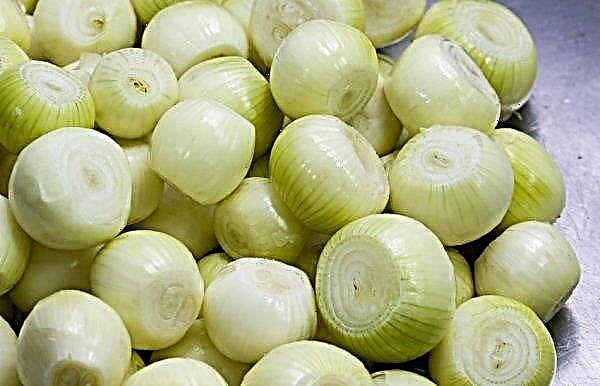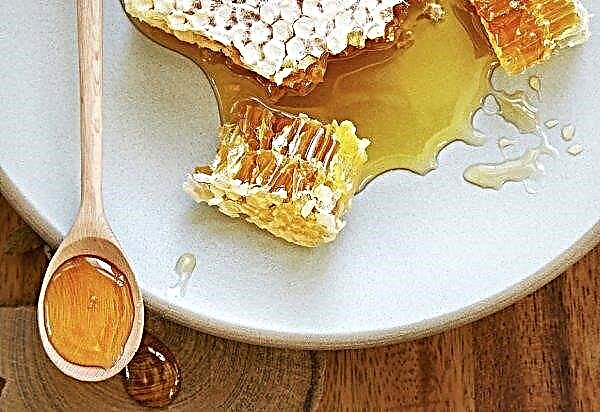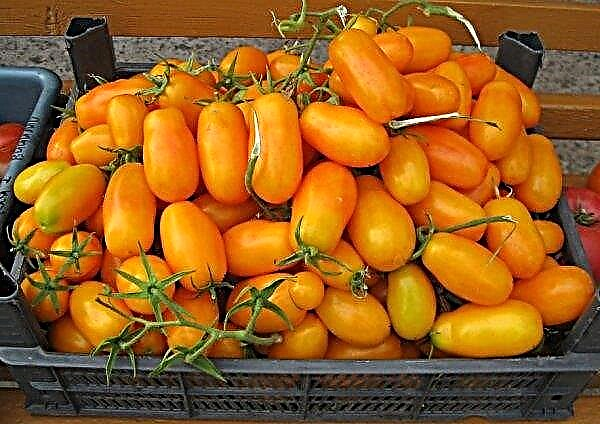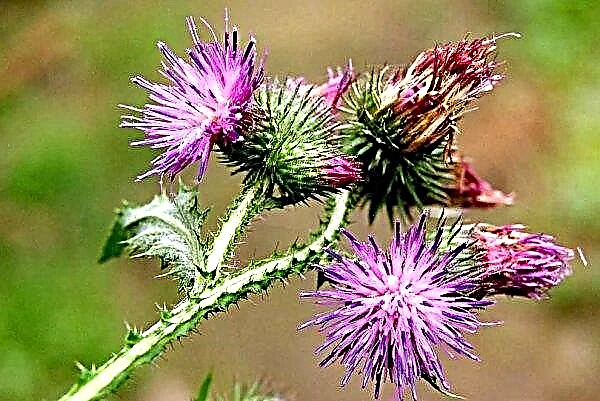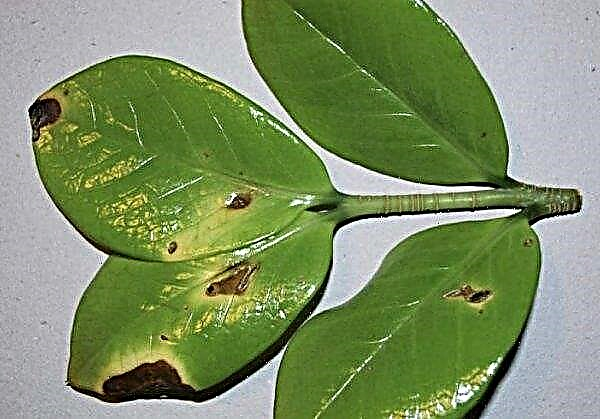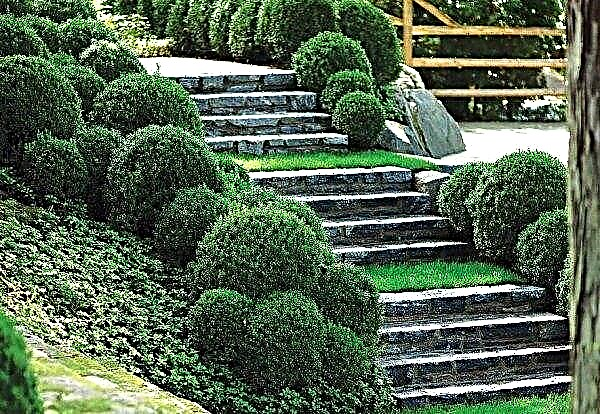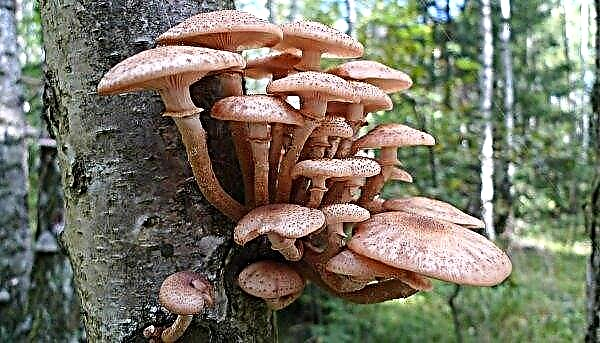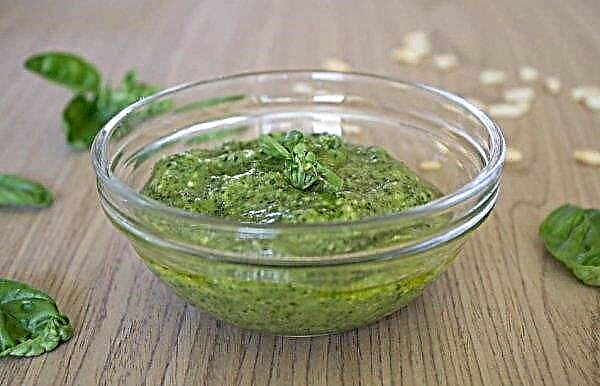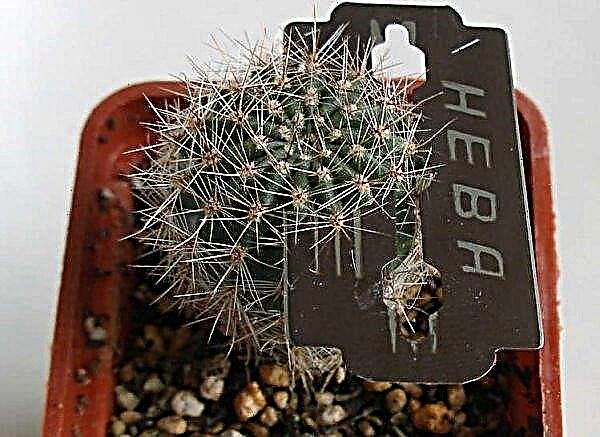Eggplant variety Robin Hood is good in everything - from wonderful gastronomic qualities to high adaptive properties, allowing to produce high yields in the most adverse conditions. Read more about this sort of eggplant in the article.
Selection and botanical description of the culture
The originator of the Robin Hood eggplant variety is the Manul selection and seed-growing agricultural company, which bred it in Russia 8 years ago.

Bushes of this variety are stunted, reaching a height of only 0.4 m, compact, do not give excessive lateral shoots. On the bushes grows up to 7 fruits, the average weight of which reaches 0.3 kg.
The eggplant bush of this variety is capable of producing up to 2.5 kg of berries, which in the botanical sense are eggplant fruits. They have a pear shape, their shiny peel is painted in purple.
The eggplant can grow up to 0.2 m long and up to 0.1 m in diameter, has a flesh of delicate consistency with high taste, a complete lack of bitterness and with a small amount of seeds.
The area of culinary application of this eggplant extends from frying and pickling to preparing caviar and drying. In addition, Robin Hood is characterized by a very early maturation, which occurs 3 months after the appearance of the first shoots and continues until the end of summer.
Advantages and disadvantages
- Thus, the eggplant variety Robin Hood has the following advantages:
- unpretentiousness in cultivation;
- high gastronomic qualities;
- early achievement of fruit maturity;
- compact bushes;
- lack of need for formation of bushes;
- the ability to take up little space on vegetable beds;
- insignificant amount of thorns;
- high and stable productivity;
- resistance to underlying diseases.
Did you know? Although eggplant is popularly called “blue”, they are never blue, but are purple, black, brown, yellow and even snow-white.
- The disadvantages, which are extremely small, include:
- the need to tie bushes to supports, the small sizes of which may not withstand the abundance of fruits;
- the need for shelter from frost during early planting in open ground;
- prolonged ripening of fruits in low light shrubs.
How to grow seedlings at home
Since this variety is distinguished by its ability to produce a consistently high yield even in the absence of optimal conditions for its growth, growing its seedlings is also not particularly difficult. But some features need to know.
The timing
Determining when it is time to sow the seeds in the soil for growing seedlings is quite simple, based on local climate conditions. In places with a temperate climate, seedlings are transplanted into the open ground from mid to late May.
Around the same time, seedlings are planted in regions with a colder climate, but in this situation, planting is carried out in greenhouses. And since at least 40 days pass from the time of sowing the seeds until the seedlings are ready for planting in the soil, usually sowing of the seeds is carried out no later than March 15.
The soil
Although this eggplant variety is able to grow safely on any soil, nevertheless, to obtain high-quality seedlings, slightly acidic or neutral soil is preferable. For disinfection, it must be calcined in the oven, 60 minutes at 90 ° C.
The best option for growing seedlings is a professionally prepared substrate sold in specialized stores. However, you can prepare quite high-quality soil with your own hands. There are several ways to make effective fertilizer mixtures.
To prepare them, mix:
- 2 parts humus with 1 part sod land;
- 3 peat parts with 1 part rotting sawdust;
- 2 parts of humus with 1 peat part.
Capacities
Tanks in which you can grow eggplant seedlings can be in the form of:
- wooden or plastic drawers with low sides;
- plastic, cardboard or paper cups;
- plastic seedling cassettes;
- pots of peat;
- peat washers.
There is no fundamental difference in the choice of capacity for seedlings. However, it should be borne in mind that the root system of eggplant perceives transplantation very negatively, so the best option when obtaining seedlings is the ability to do without picking when planting seedlings at a stationary place of growth.
In this sense, cardboard and paper cups or pots and peat tablets are preferred. They allow you to transship the seedlings into the soil without removing them from the tanks. Especially effective is growing seedlings in peat tablets, which, in addition to peat itself, which is a good fertilizer, also contain many other nutrients.
Did you know? If you rub your teeth with strips of eggplant fruit, this will effectively save them from plaque.
Seed preparation
Although eggplant seeds retain germination for up to 4 years, usually 2-year-old planting material is selected for sowing. Before planting, it is disinfected with a 1% manganese solution for half an hour, then washed in water and dried.
It is also recommended to treat the seeds with one of the growth stimulants that activate the successful germination of planting material.
Sowing seeds
Seeds are sown in a substrate no deeper than 2 cm. In this case, soil should not be compacted after sowing, as weak eggplant sprouts may not have the strength to break through the compacted soil layer.
Seeds are sown in the center of the tank in an amount of 2-3 pieces at a distance of 1 cm from each other. After the emergence of the sprouts, the strongest of them is left, and the rest are carefully cut.
Seedling Care
After sowing seeds in a tank, to create a greenhouse effect, they must be placed under a glass or a transparent film and put in a dark place with an ambient temperature of at least + 23 ° С.
When seedlings appear seedlings should be freed from the coating and moved to a sufficiently lit place with a temperature of + 14 ° C to + 16 ° C in the absence of drafts.
Good illumination, which should last at least 12 hours, will not allow the sprouts to stretch too much, and a low temperature stimulates the development of a strong root system and will serve as a good means of hardening seedlings. In early spring, good illumination can only be achieved with artificial lighting.Important! In no case should you lower the ambient temperature below +14°C, since this can lead to inhibition of seedling growth and even to its death.
During this period, a balanced watering of seedlings is very important. In the first 10 days there is enough watering with warm water in the morning, then it should be watered more actively. This is best done using a pallet, but care must be taken to ensure that water does not accumulate there. In addition, it is impossible to wet the surface of the leaves during watering, as this is fraught with the occurrence of fungal diseases.
Initially, the sprouts have enough nutrients that are present in a properly prepared substrate or in peat tablets. However, as seedlings develop, they need nutrients in increasing quantities, so they must be fed before being transplanted to a permanent place of growth.
It is best to combine fertilizing with complex fertilizers with watering, for which 25 g of fertilizers must be dissolved in a bucket of water. If there are no factory complex fertilizers, you can do it yourself.
When the first leaf appears on seedlings, it can be fed with infusion of bird droppings or mullein: for this, the infusion of bird droppings is diluted with water in a proportion of 1:20, and the infusion of mullein - 1: 5. After 10 days, they are fed with minerals, for which 8 g of potassium salt, 10 g of ammonium sulfate and 25 g of superphosphate are diluted in 5 liters of water. This solution should be poured as carefully as possible under the bush, in no case falling on the leaves.
Seedling hardening
Hardening of seedlings starts from the moment when the coating in the form of glass or a transparent film is removed from containers with seedlings and they are placed in a cool place. About 2 weeks before transplanting seedlings to a permanent place, its main hardening is carried out.
In its process, watering intensity and ambient temperature are gradually reduced, for which containers with seedlings are taken out for a couple of hours, first to the corridor, then to the glazed loggia, then to the balcony or open air in the yard, gradually increasing the duration of the seedlings in low temperature.Important! During the hardening procedure, a decrease in temperature should not be combined with a decrease in illumination.
How to transplant seedlings to a permanent place
In order for the seedlings planted on a permanent place to receive optimal conditions for their successful development, it is necessary to accurately determine the time and place of planting, as well as correctly implement this process itself.
The timing
Fully prepared for planting in a permanent place, hardened seedlings should be at least 0.15 m high, have from 6 to 9 dark green leaves and an upright trunk. She should be at least 40–45 days from the day of sowing seeds, and the age of 65 days is considered optimal for planting seedlings.
The specific time for planting eggplant seedlings for a permanent place depends on the climatic conditions in a particular region: by the time of planting in open ground, the average daily temperature of the air and soil should be stable at a minimum of + 14 ° C, and it is also necessary that the risk of frost is completely eliminated .
It should be borne in mind that the best time for planting seedlings in open ground is evening in the absence of sunlight, which allows young plants to more successfully adapt to their new environment.
Seat selection
Eggplant prefers fertile and fairly loose soil: for this, sand is added to the soil on the bed and enriched with peat or humus at the rate of up to 4 kg per 1 sq. M. m
You can also learn how to grow eggplant varieties in your area or in a greenhouse, such as:
The site must be selected where penetrates maximum sunlight and minimum winds. Undesirable close occurrence of groundwater. Of significant importance are the predecessors that grew on this site to eggplant.
For example, it is useful if previously cultivated here:
- legumes;
- cucumbers
- bow;
- cabbage.
But it is categorically not recommended to plant eggplant after solanaceous crops in the form of:
- potatoes;
- Tomatoes
- sweet pepper.
Also, experts do not recommend growing eggplants in the same place for 2 consecutive years.
Scheme and depth of landing
Wells are made in the prepared soil, the depth of which should be slightly greater than the height of the tanks, with which it is preferable to plant the seedlings in a constant place. In the hole, it is useful to pour 1 tbsp. l azofoski, after which water is poured into it.
A cup with seedlings is also abundantly poured, which is then placed in the hole. If the cup or other container is plastic, it is necessary to remove the entire earthen lump completely from it, being careful not to damage the root system of the seedling.
Planted young eggplant bushes must be protected from burning sunlight. Saplings take root in the soil slowly, gaining full strength only 3 weeks after planting. Since the varieties of Robin Hood bushes are compact enough, they have enough distance from each other of 0.3 m. And between the rows leave a distance of 0.4 m.
How to care in the open ground
Eggplant care consists of timely watering, sufficient fertilizing with fertilizers, soil treatment around the bushes and protecting them from diseases and pests.
Watering
Since this culture does not tolerate excessive soil moisture, it should be watered abundantly, not allowing the earthen coma to dry out, but not often. Young bushes are usually watered once a week. During flowering, the frequency of watering is reduced, and during the ripening period, the fruit is again speeded up.
In no case should you water the eggplant by sprinkling. The best options are pouring water into the grooves done in the ground near the bushes, or drip irrigation. However, most often water is poured directly under the root.
It should be borne in mind that water for irrigation should in no case be cold from the water supply, since it can provoke dropping of ovaries from the plant and even its death. Irrigation water must be well-maintained and warm.
Top dressing
Usually, eggplant bushes are fed three times during the season. This plant responds very well to nitrogen and potassium fertilizing, and to a lesser extent to phosphorus.
But since nitrogen, actively influencing the development of green mass, inhibits the formation of ovaries, nitrogen fertilizers should not be applied until the first fruits appear. Subsequently, it is useful to water the bushes weekly with a solution of rotted mullein or bird droppings.In addition, eggplant plants need mineral top dressing in the form of:
- gland;
- boron;
- manganese salts.
Soil care
Low bushes of the Robin Hood variety are very sensitive to the presence of tall weeds near themselves, therefore, during the season, it is necessary to repeatedly weed the beds with plants, combining weeding with loosening and hilling.
Also, loosening the soil should be carried out after each rain or watering, so that the resulting crust does not interfere with the supply of oxygen to the root system. It should be remembered that the eggplant roots are shallow and can be easily damaged by weeding and loosening.
In order to maintain the temperature and humidity conditions optimal for the root system in the soil, it is useful to mulch eggplant bushes with sawdust or mowed grass before seed formation begins.
Pest and disease protection
Most often, eggplant bushes are attacked:
- Colorado potato beetle;
- spider mite;
- aphids.
They fight it with chemicals and biological products represented by:
- "Agrovertinom";
- Fitoverm;
- “Healthy garden”;
- Iskra-bio.
Aphid harms eggplant everywhere. In the fight against it, you can use the same biological products as against the spider mite. Also effective is a folk remedy in the form of a solution of potassium permanganate and green soap (3 g of potassium permanganate and 200-250 ml of green soap in 10 liters of water).
Of the diseases, the Robin Hood variety is most often affected by late blight and tobacco mosaic.
- They fight phytophthora by means of solutions, which include copper, - Bordeaux liquid and copper sulfate; they treat the soil before planting seedlings, as well as after their rooting.

- Tobacco mosaic is more difficult to fight. At the first manifestation of this disease, the eggplant leaves must be treated with a solution of whey, 100 ml of which is diluted in 1 liter of water and some micronutrient fertilizers are added there. It is also useful to spray the bush with a solution of 1 liter of milk in a bucket of water with the addition of a few drops of iodine. In addition, replace the topsoil with 0.2 m.

Harvesting
The degree of maturity of the eggplant should be determined not by their appearance, but by the length of the fruit. Also, the maturity of the vegetable can be determined by pressing a finger on the fetus. In an immature vegetable, a dent remains for a long time, while in a mature one, it quickly levels out. Ripe fruit is best cut with garden shears. It should be remembered that the more often ripened fruits are removed from the bush, the faster the remaining ones grow.
Fresh eggplant fruits are stored in layers of straw in a cool dark place for up to 2 months. If longer storage is required, the sliced fruits are dried in a well-ventilated, cool and dry room. Fresh eggplants are also perfectly stored in freezers, in which they are sliced up quietly until the new harvest.
Robin Hood eggplants are great for absolutely all types of pickling and pickling, they are fried, stewed and baked, they make wonderful caviar. There are more than five hundred different recipes for the preparation of this vegetable, and all of them are applicable to this variety.The eggplant variety Robin Hood attracts numerous fans not only for its diverse gastronomic qualities, but also for its ability to produce consistently high yields, even under conditions that are unfavorable for other varieties of this culture.



